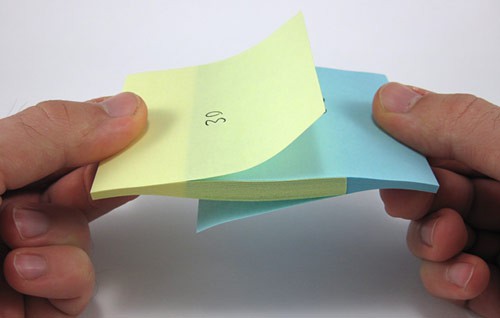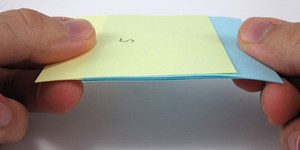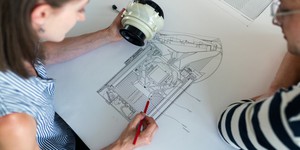Summary
Introduction
A popular science demonstration shows that when you overlap the pages of two phone books, they are nearly impossible to pull apart. Since most people do not have two phone books sitting around, we will show you how you can do the same experiment with sticky notes. Sticky notes are much smaller than phone books, so they should be easy to pull apart, right? Try this activity to find out!
Materials
- 2 pads of sticky notes (approximately 3 by 3 inches)
- Pen or pencil
Instructions
- Split your pads of sticky notes up into two stacks each of 5, 10, 20, and 30 sheets. Label the stacks with a pen or pencil so you can keep track of how many sheets they have.
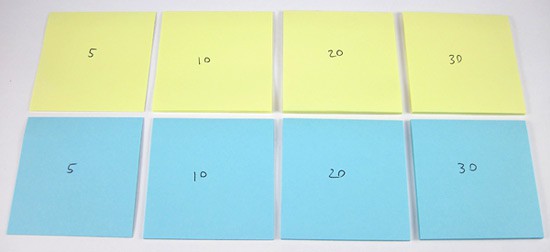 Image Credit: Ben Finio, Science Buddies / Science Buddies
Image Credit: Ben Finio, Science Buddies / Science Buddies
- Interleave the pages of each matching stack of sticky notes (the stacks with the same number of pages). Do this by overlapping the pages of each stack one at a time, like you were shuffling a deck of cards.
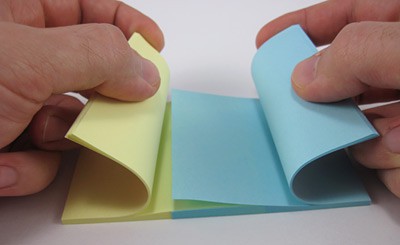 Image Credit: Ben Finio, Science Buddies / Science Buddies
Image Credit: Ben Finio, Science Buddies / Science Buddies
- Completely interleaved stacks should look like this. The exact distance the pages are overlapped does not matter, but make sure it is at least a couple centimeters.
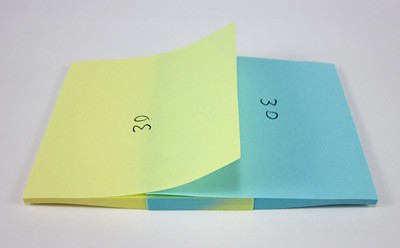 Image Credit: Ben Finio, Science Buddies / Science Buddies
Image Credit: Ben Finio, Science Buddies / Science Buddies
- Now, pull on the stacks to see if you can separate them. Start out with the smallest stack and work your way up to the largest. Make sure you pull straight out and do not twist or bend the pads at all. You can also try hanging the stacks vertically by just pinching one edge with your fingers. Do any of the stacks fall apart under their own weight? Which ones can you pull apart easily? Which ones are difficult to pull apart? Which ones can you not pull apart at all? Are you surprised at any of the results?
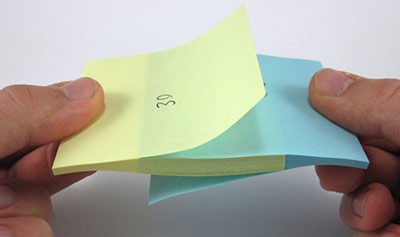 Image Credit: Ben Finio, Science Buddies / Science Buddies
Image Credit: Ben Finio, Science Buddies / Science Buddies
- If you have time, try different numbers of sticky notes. What happens if you try stacks of 15 or 25? Can you find the exact transition point where you can no longer pull the sticky notes apart?
Cleanup
- To separate sticky note pads that you could not pull apart, try bending the pads, as shown here. This will cause the pages to come apart one at a time, making them much easier to separate.
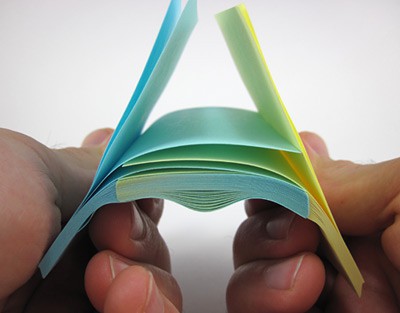 Image Credit: Ben Finio, Science Buddies / Science Buddies
Image Credit: Ben Finio, Science Buddies / Science Buddies
What Happened?
You should have found that stacks of 5 sticky notes were very easy to pull apart, as if they were barely stuck together at all. If you hold them vertically, they might even fall apart under their own weight. However, stacks of 10 sticky notes require a bit more force to pull apart—seemingly more than double the force it took to pull stacks of 5 apart. Stacks of 20 sticky notes are very difficult to pull apart, if you can do it at all, and the stacks of 30 sticky notes are nearly impossible to pull apart. Why does this happen? Go to the Digging Deeper section to learn more.Digging Deeper
Why are the larger stacks of sticky notes so difficult to pull apart? Friction! Friction is the force that opposes sliding motion between two surfaces that are touching each other. Every surface has friction, although some have more than others. For example, a slick wooden floor has less friction than a carpeted floor. The harder two surfaces are pressed together (called the normal force, or force acting perpendicular to the surface), the higher the friction force between them.
Normally, there is not very much friction between two pieces of paper or two sticky notes. However, when you interleave the pages of two stacks of sticky notes, they behave like a Chinese finger trap. The harder you pull, the harder the pages get squeezed together, increasing the normal force. The more pages you add, the larger this effect becomes. This results in a huge increase in the friction force, making them nearly impossible to pull apart. In fact, if the experiment is done at a larger scale using two phone books, those phone books can even be attached to a crane to lift the weight of an entire car!
Note: because the phone book friction experiment is very popular, there are many demonstrations of it online, and there are several common misconceptions about the physics involved. For a more thorough explanation and a list of common misconceptions, see the project idea Try the Mythbusters' "Phone Book Friction" Experiment at Home
Ask an Expert
For Further Exploration
- Try the experiment with paperback books or magazines. How many pages do you need to interleave before you can no longer pull them apart? Does the type of paper seem to matter; for example, a magazine with glossy pages versus a book with matte pages?
- How does the overlap distance of the pages affect the experiment? What happens if you overlap the pages as much as possible, or barely overlap them at all?
- Can you find "trick" methods to easily separate the sticky notes? What happens if you gently bend or twist the sticky notes in different directions, or push on them instead of pulling on them? Once you figure out how to easily separate the sticky notes, try using the experiment as a magic trick. Challenge other people to see if they can pull apart the sticky notes, and when they cannot do it, show them how easy it should be!

